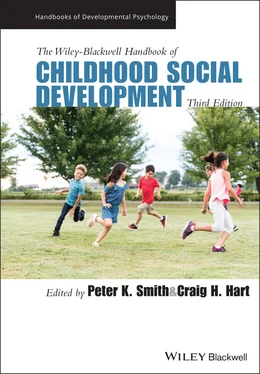17 PART X: Children and the Media CHAPTER THIRTY‐SEVEN: Media and Children’s Social Development Media as a Socializing Agent Social Context of Media Use Directions and Challenges for Future Research References CHAPTER THIRTY‐EIGHT: Social Networking Sites and Children’s Social Development Social Media Platforms and Technological Affordances Social Media Platforms and Safety: Risks, Harms and Concerns – What is at Stake? The Policy of Age‐Gating Social Media Access: Privacy and Safety Theoretical Framework for Understanding the Role of Social Media in Children’s Social Development Examining Evidence Behind SNS Use in Children and Negative Outcomes Parental Mediation of Children’s Social Media Use Children under the Age of Nine and Digital Media Use Surveillance Capitalism, Algorithmic Curation, Filter Bubbles, and Sharenting Benefits of Social Media Use for Children and Adolescents Concluding Remarks References
18 PART XI: Intervention and Social Development CHAPTER THIRTY‐NINE: Helping Autistic Children Social Communication Skills Risks of Intervention Alternative Areas of Focus The Social Model of Disability and Intersectionality LGBTQIA+ Autistic People Black and First Nations Autistic People and Autistic People of Color Conclusions References CHAPTER FORTY: Intervening in Childhood Social Development What is Social‐Emotional Development? Why is Social‐Emotional Development Important? Are Interventions that Teach Social‐Emotional Skills Effective? What are the Characteristics of Effective Intervention Programs? Why and How Do We Train Teachers to Facilitate Children’s Social and Emotional Development? What Topics are Commonly Included in Teacher Training? How Do Social and Emotional Interventions Involve Parents or Caregivers? What Factors Contribute to Successful Outcomes in Implementation of SEL Programs? Summary and Future Directions References CHAPTER FORTY‐ONE: The Development of Social Competence in Children with Disabilities Theoretical Frameworks Personal Characteristics Associated with Social Competence of Children with Disabilities Contextual Factors Associated with Social Competence of Children with Disabilities Cultural Understanding of Disabilities and Inclusion Implications and Conclusion References CHAPTER FORTY‐TWO: Interventions to Enhance Psychosocial Competence among Children in Low‐ and Middle‐Income Countries Definition and Scope Conceptual Framework and Approaches Interventions for Psychosocial Competence among Children in LMICs Conclusions Impact of Covid‐19 on the Psychosocial Development of Children Implications for Future Research References
19 Index
20 Index
21 End User License Agreement
1 Chapter 3 Table 3.1 Candidate regions that participate in the social brain. Table 3.2 Networks creating the functioning social brain (the letters in th...
2 Chapter 21Table 21.1 Adults’ role for nurturing children’s positive development throu...
3 Chapter 38Table 38.1 Classification of online risks and opportunities.
1 Chapter 3 Figure 3.1 Schematic representation of the processes guiding human cortical ... Figure 3.2 Maturation of the “baby connectome”: examples of brain networks a... Figure 3.3 Schematic illustrations depicting brain gray and white matter cha... Figure 3.4 White matter maturation from birth through 36 months of age Figure 3.5 Candidate “social brain” regions Figure 3.6 Critical regions and reciprocal relations of the social brain Figure 3.7 Network ROIs within four critical brain networks underling social... Figure 3.8 Differences in age when development peaks Figure 3.9 Distinct differences in WM maturation depending on the tract bein... Figure 3.10 An integrative, heuristic model of social competence in children...
2 Chapter 4 Figure 4.1 Developmental pathways for fast and slow life history strategies ...
3 Chapter 5 Figure 5.1 Statue of Immanuel Kant (1724–1804). Figure 5.2 Jean Jacques Rousseau (1712–1778). Figure 5.3 “Das Kind” (1809) (The Child) By Otto Runge.
4 Chapter 10Figure 10.1 Geopolitical and environmental crises’ influence on famine.
5 Chapter 20Figure 20.1 Child‐by‐environment model: Links to school adjustment.
6 Chapter 21Figure 21.1 Personal assets framework.
7 Chapter 34Figure 34.1 Prism theoretical model of social‐emotional competence by Denham...
8 Chapter 36Figure 36.1 Types of lies and the paradigms designed to study them, accordin...
9 Chapter 38Figure 38.1 EU Kids Online theoretical model (from Livingstone et al., 2018)...
1 Cover Page
2 Series Page Wiley‐Blackwell Handbooks of Developmental Psychology This outstanding series of handbooks provides a cutting‐edge overview of classic research, current research, and future trends in developmental psychology. Each handbook draws together 25–50 newly commissioned chapters to provide a comprehensive overview of a sub‐discipline of developmental psychology. The international team of contributors to each handbook has been specially chosen for its expertise and knowledge of each field. Each handbook is introduced and contextualized by leading figures in the field, lending coherence and authority to each volume. The Wiley‐Blackwell Handbooks of Developmental Psychology will provide an invaluable overview for advanced students of developmental psychology and for researchers as an authoritative definition of their chosen field. Published Blackwell Handbook of Adolescence Edited by Gerald R. Adams and Michael D. Berzonsky The Science of Reading: A Handbook Edited by Margaret J. Snowling and Charles Hulme Blackwell Handbook of Early Childhood Development Edited by Kathleen McCartney and Deborah A. Phillips Blackwell Handbook of Language Development Edited by Erika Hoff and Marilyn Shatz The Wiley‐Blackwell Handbook of Childhood Cognitive Development, 2nd edition Edited by Usha Goswami The Wiley‐Blackwell Handbook of Adulthood and Aging Edited by Susan Krauss Whitbourne and Martin Sliwinski The Wiley‐Blackwell Handbook of Infant Development, 2nd Edition Edited by Gavin Bremner and Theodore D. Wachs The Handbook of Early Childhood Development Programs, Practices, and Policies Edited by Elizabeth Votruba‐Drzal and Eric Dearing The Wiley Handbook of Developmental Psychology in Practice: Implementation and Impact Edited by Kevin Durkin and H. Rudolph Schaffer The Wiley Handbook of Group Processes in Children and Adolescents Edited by Adam Rutland, Drew Nesdale and Christia Spears Brown The Wiley‐Blackwell Handbook of Childhood Social Development, 3rd Edition Edited by Peter K. Smith and Craig H. Hart
3 Title Page The Wiley‐Blackwell Handbook of Childhood Social Development Third Edition Edited by Peter K. Smith Craig H. Hart
4 Copyright Page
5 About the Editors
6 List of Contributors
7 Introduction
8 Table of Contents
9 Begin Reading
10 Index
11 Index
12 WILEY END USER LICENSE AGREEMENT
1 ii
2 iii
3 ix
4 ix
5 xi
6 xii
7 xiii
8 xiv
9 xv
10 xvi
11 1
12 2
13 3
14 5
15 6
16 7
17 8
18 9
19 10
20 11
21 12
22 13
23 14
24 15
25 16
26 17
27 18
28 19
29 20
30 21
31 22
32 23
33 24
34 25
35 26
36 27
37 28
38 29
39 30
40 31
41 32
42 33
43 34
44 35
45 36
46 37
47 38
48 39
49 40
50 41
51 43
52 44
53 45
54 46
55 47
56 48
57 49
58 50
59 51
60 52
61 53
62 54
Читать дальше












